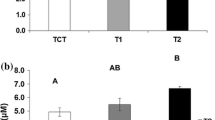Abstract
Variable and high salinities have been identified as key stressors in Florida Bay. The Comprehensive Everglades Restoration Plan (CERP) includes water redistribution projects that are intended to restore natural freshwater flows to northeastern Florida Bay. The present salinity regimes in the area, which span from hypo- to hypersaline, will be altered as a result of these actions. This research examined biological performance measures (i.e., growth and survival) of estuarine fish under varying salinity regimes that will occur as a result of the restoration of freshwater flow to the Bay. A series of acute and subchronic studies were conducted to determine the effects of salinity changes on various life stages (embryo/larval, juvenile, adult) of four native estuarine fish (Cyprinodon variegatus, Floridichthys carpio, Poecilia latipinna, and Gambusia holbrooki). Fish were exposed to a range of salinity concentrations (freshwater to hypersaline) based on current salinity profiles in the study areas. Growth (length, weight), abnormalities, and survival were measured. Salinity exposures included both rapid and gradual change events. Results show adverse effects of acute, abrupt salinity changes on fish survival and development due to salinity stress.


Similar content being viewed by others
References
Ault JS, Luo J, Smith SG, Serafy JE, Wang J, Humston R et al (1999) A spatial dynamic multistock production model. Can J Fish Aquat Sci 56:4–25. doi:10.1139/cjfas-56-S1-4
Chen JC, Lin J, Chen C, Jin M (1996) Survival, growth and intermolt period of juvenile Peneaus chinensis reared at different combinations of salinity and temperature. J Exp Mar Biol Ecol 204:169–178. doi:10.1016/0022-0981(96)02589-0
Christensen JD, Monaco ME, Lowery TA (1997) An index to assess the sensitivity of Gulf of Mexico species to changes in estuarine salinity regimes. Gulf Res Rep 9:219–229
Davis SM, Childers DL, Lorenz JJ, Wanless HR, Hopkins TE (2005) A conceptual model of ecological interactions in the mangrove estuaries of the Florida Everglades. Wetlands 25:832–842. doi:10.1672/0277-5212(2005)025[0832:ACMOEI]2.0.CO;2
Database DBHYDRO South Florida Water Management District, West Palm Beach, Florida. www.sfwmd.gov/org/ema/dbhydro
Faunce CH, Serafy JE (2002) Fish utilization of mangrove fringe habitats within Southeastern Florida. Final Rep (Submitted to). United States Department of the Interior, U.S.G.S.-Biological Resources Division, Florida/Caribbean Science Center, restoration Ecology Branch, Center for Coastal Geology & Regional Marine Studies, St. Petersburg, Florida
Holt GJ, Holt SA (2003) Effects of variable salinity on reproduction and early life stages of spotted seatrout. In: Bortone SA (ed) Biology of the spotted sea trout. CRC Press, LLC, Boca Raton, Florida, pp 135–146
Ley JA, Montague CL, McIvor CC (1994) Food habits of mangrove fishes: a comparison along estuarine gradients in northeastern Florida Bay. Bull Mar Sci 54:881–889
Lodge TE (2005) The everglades handbook: understanding the ecosystem, 2nd edn. CRC Press, Boca Raton, Florida
Lorenz JJ, Serafy JE (2006) Subtropical wetland fish assemblages and changing salinity regimes: implications for everglades restoration. Hydrobiologia 561:401–422. doi:10.1007/s10750-006-0145-9
Montagna PA, Alber M, Doering P, Connor MS (2002) Freshwater inflow: science, policy, management. Estuaries 25:1243–1245
Nordlie FG (2000) Patterns of reproduction and development of selected resident teleosts of Florida salt marshes. Hydrobiologia 434:165–182. doi:10.1023/A:1004073125007
Nordlie FG (2006) Physiochemical environments and tolerances of cyprinodontoid fishes found in estuaries and salt marshes of eastern North America. Rev Fish Biol Fish 16:51–106. doi:10.1007/s11160-006-9003-0
Serafy JE, Lindeman KC, Hopkins TE, Ault JS (1997) Effects of freshwater canal discharge on fish assemblages in a subtropical Bay: field and laboratory observations. Mar Ecol Prog Ser 160:161–172. doi:10.3354/meps160161
Tsuzuki MY, Cavalli RO, Bianchini A (2003) Effect of salinity on survival, growth, and oxygen consumption of the pink shrimp Farfantepenaeus paulensis (Perez-Farfante 1967). J Shell Res 22:555–559
US EPA (2002) EPA-821-R-02-014.Short-term methods for estimating the chronic toxicity of effluents and receiving waters to marine and estuarine organisms. Washington, DC
Varsamos S, Nebel C, Charmantier G (2005) Ontogeny of osmoregulation in postembryonic fish: a review. Comp Biochem Physiol 141:401–429. doi:10.1016/j.cbpb.2005.01.013
Acknowledgements
This research was funded by Everglades National Park, DOI Cooperative Agreement Number H5284020094. This is SERC contribution no. 392.
Author information
Authors and Affiliations
Corresponding author
Rights and permissions
About this article
Cite this article
Bachman, P.M., Rand, G.M. Effects of salinity on native estuarine fish species in South Florida. Ecotoxicology 17, 591–597 (2008). https://doi.org/10.1007/s10646-008-0244-7
Received:
Accepted:
Published:
Issue Date:
DOI: https://doi.org/10.1007/s10646-008-0244-7




